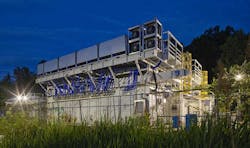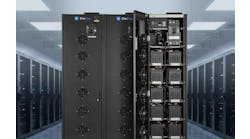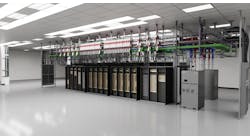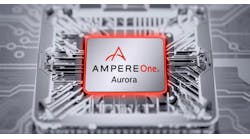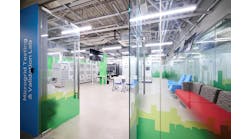Rethinking the Data Center: Hydrogen Backup is Latest Microsoft Moonshot
In the two years since it announced plans to become a carbon negative company, Microsoft has accelerated its bid to rethink the data center. Its research groups have unveiled a series of innovations to reduce the impact of its computing operations on the environment. The latest of these “moonshots” is the deployment of a 3-megawatt hydrogen generator producing that can replace diesel generators.
Microsoft and equipment partner Plug Power successfully tested the system, which pushes the boundaries of scalability for hydrogen fuel cells.
“What we just witnessed was, for the datacenter industry, a moon landing moment,” said Sean James, Microsoft’s director of datacenter research, after the June test at a Plug facility in Latham, N.Y. “We have a generator that produces no emissions. It’s mind-blowing.”
The hydrogen generator is part of a broader initiative to make data centers more sustainable. Microsoft wants to change the way they power, cool and manage a fleet of millions of servers across the globe. It is the boldest example of how hyperscale cloud operators are applying their technology, innovation and financial strength to slash the climate impact of data centers and build a digital future that doesn’t harm the planet.
Harnessing Innovation Leadership
Cloud operators like Microsoft are some of the largest users of energy. As the world confronts the growing urgency of the climate crisis, top cloud computing companies are stepping up their sustainability efforts. These huge tech companies are already the largest purchasers of renewable energy, and were among more than 70 companies joining the iMasons Climate Accord, which calls for new steps to track and reduce the environmental impact of the data centers that power the Internet.
Even among the strong industry responses, Microsoft has stood out with the volume of its R&D innovation to create greener data centers. These projects include:
- Grid-Interactive UPS Systems: Microsoft data centers will soon begin sharing energy from their UPS battery storage systems with Ireland’s power grid, part of a growing movement for data centers to collaborate more closely with the utility industry.
- Data Center Microgrids: Microsoft will integrate a microgrid at a new data center in San Jose, Calif., which will use renewable natural gas (RNG) instead of diesel fuel to power its emergency backup generators. The project with Enchanted Rock advances Microsoft’s goal of moving off diesel fuel by 2030.
- Cleaner Generator Fuel: While it advances its development of microgrids and hydrogen fuel cells, Microsoft will begin using lower-carbon renewable fuel for data center generators at its cloud region in Sweden.
- Slashing Water Usage: The company will reduce the use of water in its data centers by 95 percent by 2024 by refining how it designs and operates its massive cloud infrastructure. including operating its data centers at warmer temperatures.
- Using Immersion to Cool Servers: Microsoft has begun using immersion-cooled servers in production, the company said this week. The announcement is a meaningful milestone for adoption of two-phase immersion, which promises major gains in density and efficiency, and will also reduce the water use of its computing operations. Immersion may also help servers run faster by enabling more overclocking of processors.
- Next-Generation Data Storage: Microsoft is working on new storage technologies to house massive amounts of data in DNA and holograms. These storage technologies could disrupt how data centers are designed and operate.
- Low-Carbon Buildings: New research from Microsoft outlines the potential use of sustainable material in data center construction projects to create low-carbon cloud infrastructure. It is exploring the use of mushrooms, algae, agricultural waste and hemp as structural materials.
That’s a ton of innovation within a two-year period, and doesn’t even include Microsoft’s underwater data center Project Natick, which pushed the boundaries of where the cloud could live, and also found that servers housed in a sealed nitrogen environment were substantially more reliable than those in traditional data centers.
The Promise of Hydrogen Power
Hydrogen has always been envisioned as a potential fuel to power a clean revolution, as we noted in our recent DCF roundtable. But hydrogen fuel cells have remained elusive as a production option, lacking the economics and scale for data center production.
That began to change in July 2020, when Microsoft announced plans to end its reliance on diesel fuel by 2030, a decision with major implications for data centers around the world. Diesel generators play a central role in ensuring that mission-critical data center applications never go offline, as part of a redundant electrical infrastructure that also includes uninterruptible power supply (UPS) systems and batteries.
Several weeks later, Microsoft said it ran a row of 10 racks of Microsoft Azure cloud servers for 48 hours using a 250-kilowatt hydrogen-powered fuel cell system at a facility near Salt Lake City, Utah. That laid the groundwork for the 3-megawatt generator test with Plug Power, which brings development to a new level.
“Three megawatts is super interesting because that’s the size of the diesel generators that we use right now,” said Lucas Joppa, Microsoft’s chief environmental officer.
The Microsoft hydrogen generator uses a fuel cell technology known as proton exchange membrane (PEM) that combine hydrogen and oxygen in a chemical reaction that generates electricity, heat and water – with no combustion, no particulate matter and no carbon emissions.
Once green hydrogen is available and economically viable, this type of stationary backup power could be implemented across industries, from datacenters to commercial buildings and hospitals. PEM fuel cells are commonly used in the automotive industry because, like diesel engines, they are quick to turn on and off, and can follow a load up and down.
That fast reaction and load following capability is well suited for backup power at datacenters, said Mark Monroe, a principal infrastructure engineer on Microsoft’s team for datacenter advanced development.
“We started looking at the projections of the costs and the availability of hydrogen and we started to really believe that this might be a solution,” said Monroe. “And, so, we built a vision. It took us from a rack to a row to a room to a datacenter.”
The Road Ahead
Plug Power is a leader in energy products using green carbon, produced by splitting water into hydrogen and oxygen using renewable electricity. There are other flavors of hydrogen fuel that use less sustainable methodology, including “blue” hydrogen sourced from methane or natural gas.
Plug says it is now focused on rolling out an optimized commercial version of high-power stationary fuel cell systems that have a smaller footprint and a more streamlined and polished aesthetic than the one on the pad adjacent to the parking lot in Latham.
Microsoft will install one of these second-generation fuel cell systems at a research datacenter where engineers will learn how to work with and deploy the new technology, including the development of hydrogen safety protocols. The date of first deployment at a live datacenter is unknown, though it will likely occur at a new datacenter in a location where air quality standards prohibit diesel generators, James noted.
“I’m going to turn around when the excitement dies down and start to ask, ‘Okay, we did one, where can I get 1,000?’” he said. “We’ve got a commitment to be completely diesel free, and that supply chain has got to be robust – we’ve got to talk about scale across the entire hydrogen industry.”

